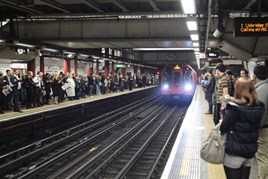Entry into traffic followed lengthy testing. Initially this was carried out between Amersham and Watford, and began on November 9 2009. Driver training started two months later, and the first S8 entered traffic on July 31 2010, running between Wembley Park and Watford.
Almost a year later, on June 27 2011, S8s were running along the entire ‘Met Line.’ The last S8 was delivered on September 15 2012.
Meanwhile, by then the first S7 had entered traffic on the H&C, running from Hammersmith to Moorgate on July 6 2012. These trains are longer than those they replaced (the C-Stock had six vehicles, as opposed to the seven in an S7). This meant platforms required extending, and so a ‘normal service’ was not possible until that work was completed.
However, as with the East London Line and its longer Class 378s, this was not possible at some stations such as at Baker Street. The S-Stock is therefore fitted with Selective Door Opening (SDO) to enable the trains to be used.
The first use of an S7 running east of Moorgate was on December 4 2012, when one ran to Barking for testing. Five days later, S7s began operating on the full length of the H&C line, and this was fully taken over by the new trains on February 10 2014.
The first Circle Line trains (S7s) entered traffic on September 2 2013, with all C-Stock replaced by February 10 2014. When they were introduced on the Circle Line, LU’s then Chief Operating Officer Phil Hufton said: “After more than 40 years in service, it is now time for the next generation of trains that are walk-through, air-conditioned and more accessible to transport commuters for the next 40 years.
“We are carrying more passengers today than ever before, with more than 1.265 billion journeys made in the last year. Much work has already been done with the completion of the Victoria and Jubilee Lines upgrades, which have provided increased reliability and capacity, and the Northern Line modernisation will be completed later this year.
“However we need to continue with investing and modernising the network to meet the growing demand of a rapidly increasing population. There is still much to do, but with each improvement that we are making we are building a Tube network truly fit for the future.”
The final line to receive the trains is the District Line. This is partly because the D-Stock had only recently been refurbished (in 2005-2008).
The first S7 ran between Olympia and West Ham on September 2 2013. On February 6 2014, S7s began running between Wimbledon and Edgware Road, and on June 13 last year they began on trains to Ealing Broadway. Revenue-earning trains started running to Richmond on June 17 last year, and to Upminster on January 16 this year. Bombardier says that the full rollout of the fleet on the District Line relies upon infrastructure upgrades being completed.
Vehicles are being constructed at a rate of six per week (that has risen from three per week before Christmas). At its height, 18 vehicles per week were being constructed at Derby.
Bombardier has made improvements to the production line process, and the ‘S-Stock’ production line is now a showcase, the company believes.
“We can deliver high quality,” says Doolin. “A lot of work has changed and we are doing far more testing up front. The looms, for instance, are produced here, which is something we have brought in-house recently.”
Automatic testing equipment is used on the trains - it looks at the possible faults and then removes them during construction.
Says Doolin: “The fact that we assemble vehicles and the fact that we build sub-assemblies allows us to produce a high rate of high-quality stock.”
With a new fleet, some modifications can be required. This was the case with the S-Stock, whereby some of the trains had to return to Derby. Doolin explains: “The main reason for that was that we had to lift them because of a bearing issue. We did modifications here . It is far better to do that here where you have better access than at the depot.”
When there are problems with the trains, Bombardier says it likes to see itself as the provider of solutions, as well as the provider of the train.
While the S8s are recording more than 75,000km per failure, the S7s are recording 40,000km between failures. That is put down to new vehicles being used on older infrastructure.
Says Doolin: “We work closely with TfL and run joint team effectiveness sessions, taking people out of their conventional environment.”
“It is worth remembering that London Underground is a complex Victorian railway being upgraded. Staff are learning computerised trains and that is such a step change. We have to make sure that they are OK and that the trains are OK.”
S-Stock offers Bombardier a unique opportunity when bidding for the 250-train New Tube For London contract (see pages 28-31 of this special supplement).
Doolin says: “We are the only supplier currently providing air-conditioned stock on the Tube. We understand the issue and we have over two million engineering hours experience already with London Underground. We are trying to offer that,” says Doolin.
Bombardier says the key challenge is taking the technology that has proven itself successfully on the S-Stock and putting it into a train the size of the Victoria Line fleet. Elements of both can be used for the NTfL deal, but there is a lot of re-designing required.
The performance of the S-Stock fleets, as well as the Victoria Line and main line fleets, suggests that Bombardier must be doing something right.
- This feature was published in RAIL 767 on February 4 2015















Login to comment
Comments
jakjaye - 20/01/2016 14:06
8MPH slower and less seating?funny thing progress!